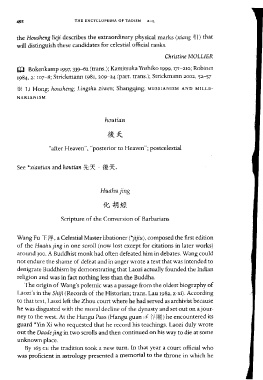Page 532 - The Encyclopedia of Taoism v1_A-L
P. 532
492 THE ENCYCLOPEDIA OF TAOISM A-L
the Housheng lieji describes the extraordinary physical marks (xiang ffl) that
will distinguish these candidates for celestial official ranks.
Christine MOLLIER
W Bokenkamp I997, 339-62 (trans.); Kamitsuka Yoshiko I999, I7I- 2IO; Robinet
I984, 2: I07-8; Strickmann I98I, 209-24 (part. trans.); Strickrnann 2002,52-57
* Li Hong; housheng; Lingshu ziwen; Shangqing; MESSIANISM AND MILLE-
NARIANISM
houtian
"after Heaven", "posterior to Heaven"; postcelestial
See * xiantian and houtian :5t: 7( . :f& 7(.
Huahujing
1t ';j] #&
Scripture of the Conversion of Barbarians
Wang Fu :f.1'f, a Celestial Master libationer (*jijiu), composed the first edition
of the Huahu jing in one scroll (now lost except for citations in later works)
around 300. A Buddhist monk had often defeated him in debates. Wang could
not endure the shame of defeat and in anger wrote a text that was intended to
denigrate Buddhism by demonstrating that Laozi actually founded the Indian
religion and was in fact nothing less than the Buddha.
The origin of Wang's polemic was a passage from the oldest biography of
Laozi's in the Shiji (Records of the Historian; trans. Lau I982, x-xi). According
to that text, Laozi left the Zhou court where he had served as archivist because
he was disgusted with the moral decline of the dynasty and set out on a jour-
ney to the west. At the Hangu Pass (Hangu guan Fi, it rijjiJ) he encountered its
guard *Yin Xi who requested that he record his teachings. Laozi duly wrote
out the Daode jing in two scrolls and then continued on his way to die at some
unknown place.
By 165 CE the tradition took a new rum. In that year a court official who
was proficient in astrology presented a memorial to the throne in which he

